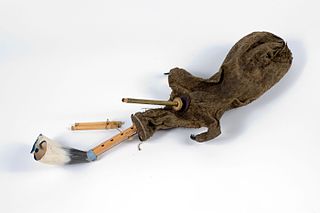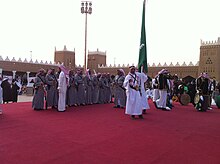
The music of Saudi Arabia includes both Western and traditional music. The most distinguished musician in recent Saudi history is Tariq Abdulhakeem, who composed hundreds of famous Saudi songs for himself as well as for other singers; Saraj Omar has become a very prominent composer after writing the music for the Saudi national anthem; Mohammed Abdu, dubbed the artist of the Arab world; Talal Maddah who died in August 2000 while singing in the summer festival on the stage of Al-Muftaha Theatre in the southern region of Saudi Arabia. The 1st Arab Pioneers Festival, which was held in Cairo under the patronage of the Arab League, honored four of the lead composers in Saudi Arabia: Tariq Abdulhakeem, Ghazi Ali, Mohamed Alsenan, and Mohammed Shafiq Chughtai. Of the same generation are the oud virtuoso Abadi al Johar, Rabeh Saqer and Abdul-Majeed Abdullah.

Kuwait is well known in the region for its exploration of many different and new forms of music and dance. Kuwait is the birthplace of various popular musical genres such as sawt. Kuwait is widely considered the centre of traditional music in the GCC region.

The Eastern Province, also known as the Eastern Region, is the easternmost of the 13 provinces of Saudi Arabia. It is the nation's largest province by area and the third most populous after the Riyadh and Mecca provinces. In 2017, the population was 4,900,325. Of these, 3,140,362 were Saudi citizens and 1,759,963 were foreign nationals The province accounts for 15.05% of the entire population of Saudi Arabia and is named for its geographical location relative to the rest of the kingdom.

The music of Qatar is based on sea folk poetry, song and dance. The historical importance of pearl fishing have deeply resonated within the region's artistic expression, manifesting in melodies, tunes, and dances that reflect the enduring bond between humanity and the sea. Traditional dances in Doha are performed on Friday afternoons; one such dance is the Ardah, a stylized martial dance performed by two rows of dancers who are accompanied by an array of percussion instruments, including al-ras, mirwas and cymbals with small drums. Other folk instruments include the oud and rebaba, both string instruments, as well as the ney and sirttai, which are types of flutes.

Sawt is a kind of popular music found in Kuwait and Bahrain.

Fidjeri is the specific repertoire of vocal music sung by the pearl divers of Eastern Arabia's coastal Gulf states, especially Bahrain and Kuwait. A lead singer is backed up by a chorus of accompanying singers and clapping. The accompanying instruments to a fidjeri ensemble are a small double-sided hand-drum, known as the mirwās and the jāhlah, a clay pot played with both hands.

Saleh (1908–1986) and Daud (1910–1976) Al-Kuwaity were Kuwait-born Israeli musicians of Iraqi-Iranian ancestry who rose to prominence in the Arab world in the early twentieth century. The brothers had a pioneering role in the modern classical music of Iraq and Kuwait, especially the Iraqi maqam and Kuwaiti sawt genres. In 1951, the brothers immigrated from Iraq to Israel.

Eastern Arabia, is a region stretched from Basra to Khasab along the Persian Gulf coast and included parts of modern-day Bahrain, Iraq, Kuwait, Oman, Qatar, Saudi Arabia, and the United Arab Emirates. The entire coastal strip of Eastern Arabia was known as "Bahrain" for a millennium.

The yowlah, is a weapon dance of the United Arab Emirates, traditionally performed during weddings, celebrations, and other events. The dance is accompanied by traditional music, and men and women are represented in separate groups of dancers. The yowlah originated as a Bedouin war dance where men would spin rifles after victory in a battle. There is also a variation from the standard yowlah known as the razfah ; and the ardah is sometimes considered a form of the yowlah.

Banu Yam is an Arabian tribe that belongs to the Qahtanite branch of Arabian tribes, specifically the group known as Banu Hamdan, and are, therefore, native to southwestern Arabia.
Al-Ajman or al-'Ijman is an Arabian tribal confederation in the Arabian Peninsula, with Ajman spread across Saudi Arabia, Qatar, the United Arab Emirates and Kuwait.

There is a rich and ancient culture in Eastern Arabia. The culture in this region has always been oriented towards the sea.

The habbān is a type of bagpipe used in the coastal regions of the Persian Gulf. The term ḥabbān (هبان) is one of several Arabic terms for the bagpipes. The term is drawn from Hanbān (هنبان), the Persian word for "bag.". In Gulf states the term habban refers to the traditional Holi bagpipe. The habbān is also called the jirbah (جربة). It is similar to the Ney-anbān and jirba.

Peninsular Arabic are the varieties of Arabic spoken throughout the Arabian Peninsula. This includes the countries of Saudi Arabia, Yemen, Oman, United Arab Emirates, Kuwait, Bahrain, Qatar, Southern Iran, Southern Iraq and Jordan.

Khaleegy' or Khaliji is a mixture of modern style and traditional folkloric dance from the Persian Gulf countries of Iraq, Saudi Arabia, Kuwait, Oman, Bahrain, Qatar and the United Arab Emirates. The name of the dance literally means "gulf" in Arabic and it is performed by women at weddings and other social events. Over time it gained popularity among belly dancers.

Lisa Urkevich is a specialist in the music and heritage of Saudi Arabia, Kuwait, and the greater Arabian Peninsula. She has undertaken extensive additional scholarship on Northern European Renaissance music, and is currently the director of a music and research center in Jeddah, Saudi Arabia. She is the former professor of musicology and ethnomusicology, and founding division head (dean) of the arts and humanities and chair of the music and drama department at the American University of Kuwait (2004-2023). Previously, she was a full-time professor at Boston University. Since 2017 she has been the general editor of Symposium: Journal of the College Music Society, the largest consortium of college, conservatory, university, and independent musicians and scholars. Urkevich is a two-time Senior Fulbright Scholar, the recipient of the 2015 University of Maryland Alumna of the Year Award, a Harvard University Fellow, and the author of numerous publications including the "pioneering work," Music and Traditions of the Arabian Peninsula: Saudi Arabia, Kuwait, Bahrain, and Qatar.

Arab folk dances, also referred to as Oriental dance, Middle-Eastern dance and Eastern dance, are the traditional folk dances of the Arabs in Arab world. Arab dance has many different styles, including the three main types of folklore, classical, and contemporary. It is enjoyed and implemented throughout the Arab region, from North Africa to the Middle East.
The Saudi Heritage Preservation Society (SHPS) is a Saudi charitable society established on 17 May 2010 and concerned with the preservation of national heritage where the constituent meeting was held in the National Museum of Saudi Arabia. It has been registered by UNESCO as an international nongovernmental organization in safeguarding heritage.

Mezmar or mizmar is a traditional group performance and stick song-dance that is performed by in the Hejaz region in western Saudi Arabia for festive occasions such as wedding and national events. Almezmar is performed by about 15–100 practitioners in festive occasions such as wedding and national events, they twirl long sticks, beat drums and clap to songs that can pertain to a variety of topics such as heroism, praise, chivalry, love and generosity. In the past, the ritual was associated with battle or competition. It closely resembles the tahtib dance practiced in Egypt and Sudan.


















